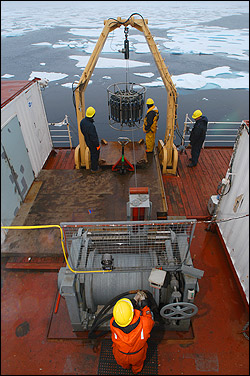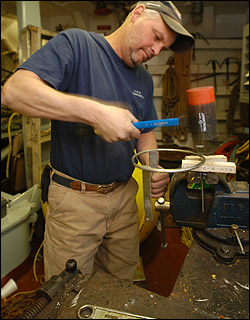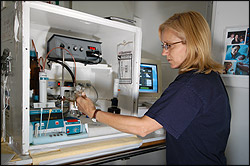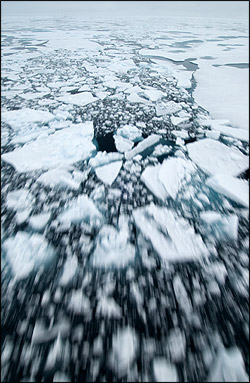Please note: You are viewing
the unstyled version of this website. Either your browser does not support CSS
(cascading style sheets) or it has been disabled. Skip
navigation.
Chris LinderAugust 15, 2005
As we made good time through the Healy's rubble, the mooring group was busy with the float factory and preparing instruments for tomorrow's deployment of Mooring B. Rick Krishfield was wearing a larger-than-normal grin today as well. "The Ice-Tethered Profiler at Camp Smiley has already sent data back to our computers at Woods Hole!" he told me. In the mooring lab, Rick showed me plots of data from the very first profile. Using software that he created, the data from the ITP is automatically plotted and sent to a website. It's incredible to think that just a few days ago those instruments were sitting in boxes--now they are out there on the ice floe, measuring and sending us their findings. The CTD group was busy analyzing water samples in the main lab. Today I stopped by Mary Steel's desk, where she was calculating the amount of dissolved oxygen in her water samples. We are collecting the oxygen data in two different ways: through a sensor on the CTD that gives us measurements every meter and through Mary's analysis of the sample water which gives us measurements at 24 depths. As the cruise progresses we can compare the two to see how the sensor is behaving. I asked Mary how they are comparing. "Lately, not very well at all" Mary tells me. "We think there is a problem with the sensor; the data have been getting farther and farther out of calibration. So, at this point the only reliable oxygen data we have are the water sample points." Dissolved oxygen, like freon, is useful in determining the origin and movement of Arctic waters since different water masses carry different amounts of dissolved oxygen. It can also tell us about the biological activity because phytoplankton produce oxygen and the bacteria and zooplankton consume oxygen. As I finish this dispatch, the midnight sun is shining brightly through a thin veil of fog on the horizon. Looks like it's going to be a beautiful night. Hopefully the weather will hold for our mooring deployment tomorrow--it always makes the deck work go faster. Last updated: October 7, 2019 | ||||||||||||||||||||||
Copyright ©2007 Woods Hole Oceanographic Institution, All Rights Reserved, Privacy Policy. | ||||||||||||||||||||||






